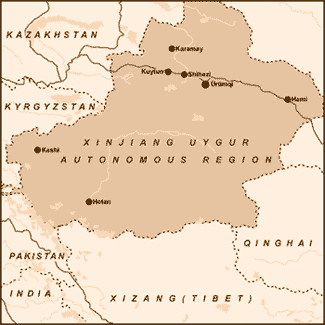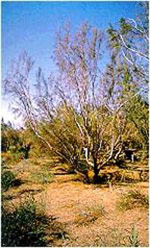Return to ITM Online
CISTANCHE
and Endangered Species Issues Affecting the Herb Supply
by Subhuti Dharmananda, Ph.D., Director, Institute for Traditional Medicine, Portland, Oregon
BACKGROUND
Cistanche is known in Chinese as roucongrong, which refers to the fleshy or meaty nature (rou) of the part used (the stem) and to its effects, which are calm and leisurely (congrong), that is, smooth, not sudden or harsh in tonifying yang (in contrast to other herbs that have a more vigorous action). It is obtained from various species of the genus Cistanche, mainly Cistanche salsa and Cistanche deserticola, but also from Cistanche tubulosa, C. sinensis, and C. ambigua. This is a genus of desert plants that are found worldwide, though the Chinese species differ from those in other countries; C. tubelosa is also found in the Mid-East. All the species of Cistanche, and the entire plant family to which they belong (Orobanchaceae), are parasitic: they lack chlorophyll and get their nutrients and water from other plants.

| Cistanche salsa is a parasite on the roots of Kalidium (see photo below, left) as well as on species of Halostachys, Halocnermum, or Salicornia. The stubby rhizome of Cistanche is attached to the fine roots of the host plants (photo left). The stems of cistanche are sliced to produce the pharmacy materials (photo, below, right).
Modern use of cistanche in Chinese herbalism is to treat yang deficiency that contributes to fertility problems (including impotence and female infertility) and reproductive system disorders such as profuse menstrual bleeding or leukorrhea. Additionally, it is used for coldness of the lower back and legs that leads to pain (e.g., lumbago) or weakness (e.g., muscle flaccidity). As a secondary property, cistanche is a mild laxative for dry stool.
|
 
|
The active ingredients isolated from Cistanche include iridoid and phenylpropenoid glycosides, such as acetoside (also called verbascoside, named for Verbena, from which it was first isolated), echinacoside (also found in the Western herb echinacea), and cistanoside (named for cistanche). The active constituents of cistanche are quite similar to those of another kidney tonic, rehmannia, which is a yin nourishing tonic. In fact, all three of these glycosides are also found in rehmannia, along with its primary iridoid glycoside, catalpol. Rehmannia and cistanche are both rich in sterols, such as daucosterol and sitosterol. Thus, it could be that the "gentle" nature of cistanche as a yang tonic is due to having ingredients that also nourish yin.
TRADITIONAL USES
The uses of cistanche have evolved over nearly 2,000 years. Cistanche was described in the oldest surviving herb classic, Shennong Bencao Jing (ca. 100 A.D.), as follows (1):
Cistanche is salty. It mainly treats the five taxations and seven damages, supplements the center, eliminates cold and heat and pain in the penis, nourishes the five viscera, strengthens yin, and boosts essence qi. In females, it makes pregnancy possible and treats concretions and conglomerations. Protracted taking may make the body light.
Although classified as salty, cistanche actually has little salty taste and is somewhat sweet and slightly bitter. The "five taxations and seven damages" refer to an ancient concept for adverse influences that serve as a basis for deficiency of fluid essences (deficiency of blood, yin, jing); there can be several causes including genetic problems and the effects of debilitating diseases. As a tonic, cistanche is mentioned here as supplementing the center (stomach/spleen), nourishing the five viscera (five zang organs), strengthening yin, and boosting the essence. Note that the modern application of treating yang deficiency, cold pain of the lower body, and impotence are not part of the original description, but treating infertility was already a recognized effect. Although there is mention of treating concretions and conglomerations (these terms usually refer to abdominal masses), there is no mention of its use for constipation.
Cistanche is not frequently included in ancient formulas. It mainly appears in large tonic formulas that were described during the Ming Dynasty or later. One of the oldest formulas containing cistanche that comes down to us today is a 14-herb combination called Huan Shao Dan (Youth Returning Pill), designed to restore kidney essence and, thereby, help restore youth and prevent further degeneration with aging (2). Its origins are obscure and attributed to various authors, dating back to the Song Dynasty or earlier. It is today sometimes called Lycium Formula, used in Japan and Taiwan as a tonic for kidney deficiency syndromes, including blurred vision, dizziness, hair loss, poor memory, and palpitation, though it is mainly promoted as a treatment for impotence (3). Using today's classification of herbs in the Chinese Materia Medica, only three of its ingredients are yang tonics (cistanche, eucommia, and morinda) that might be directly associated with the modern approaches to impotence treatment based on using multiple yang tonic herbs. A simplified version of Huan Shao Dan is produced in China as a patent remedy called Congrong Bushen Wan (Cistanche Kidney Tonic Pills) with rehmannia, cistanche, and schizandra (sometimes with dioscorea and lycium) as key ingredients from the Huan Shao Dan, and cuscuta to replace the other herbs of the original formula (4).
One of the Ming Dynasty formulas with cistanche-and one of the few in which it is a main ingredient-is Bushen Cishi Wan (Magnetite Pill for Nourishing Kidney) from Shenshi Yaohan (Precious Book of Ophthalmology) by Fu Renyu published in 1644 (the last year of the Ming Dynasty). The formula is a pill comprised of equal parts of five herbs: cistanche, cuscuta, magnetite, chrysanthemum, and haliotis. It is used for vision disorders, especially obscured vision (perhaps for floaters, cataracts, and macular degeneration). This text also yielded the better known vision formula Mingmu Dihuang Wan (Rehmannia Pill to Brighten the Eyes), which similarly includes the eye nourishing ingredients chrysanthemum and haliotis.
Thus, in general, cistanche is utilized in formulas for tonifying the kidney and used for disorders associated with aging and decline of kidney essence. Though classified as a yang tonic, it has yin nourishing qualities. These attributes are also associated with cuscuta seed, which is classified with the yang tonics but has yin nourishing qualities and mild action. Cistanche and cuscuta are frequently combined in formulas.
ENDANGERED SPECIES ISSUE
One species of Cistanche, C. deserticola (see photo, right), used as a source of the Chinese herb roucongrong, was placed on the CITES (Convention on International Trade in Endangered Species) Appendix 2 (this appendix is a list of endangered species which are not banned from trade, but require monitoring). This species was indicated several years ago as the primary source material in the official Pharmacopeia of China (5). The herb material is only restricted in international trade, and only in its crude form (e.g., sliced stems, inadvertently listed as roots in the CITES notation). Products manufactured in China that are made from cistanche (e.g., its extracts) or that include the herb (e.g., prepared formulas) are not restricted. Fortunately, many involved with the herb trade have been able to follow the provisions of the convention. Moreover, Cistanche salsa is the preferred source material, as it has the highest contents of echinacoside (2.1%) and acteoside (1.5%) of the genus Cistanche (6).
| 
|

| According to CITES (7), Cistanche deserticola is found only in China but is widely distributed in China's deserts including in Gansu, Shaanxi, and Qinghai Provinces, and the Autonomous Regions Xinjiang Uygur (see map, left), Ningxia Hui, and Inner Mongolia. This particular species is known in the Chinese herb trade as suosuo dayun. Cistanche deserticola parasitizes the roots of the desert shrub Haloxylon (mainly H. ammodendron) which grows at elevations of 225-1150 meters. It is collected in the spring when the sprouts have not come out of the ground or have just come up. Inner Mongolia is the top native-producing area of the species; annual production is about 70 tons. The species is also widely distributed in the northern part of Xinjiang Uygur, where annual output is about 50 tons. The annual production of Cistanche has been on the order of 450-550 tons, and world trade volumes (mostly exports to Hong Kong and Japan) have been about 120 tons per year.
|
The population of the species has notably decreased and its distribution area has shrunk. The demand in the international market for cistanche has grown quickly in recent years, especially with heavy promotion of the herb for use in treating impotence and infertility. As the living conditions in China improve, more people are turning to consumption of tonics, including the anti-aging tonic formulas made with cistanche, so it has greater domestic use as well. Collectors of the wild plants have not practiced any propagation of new plants, so the increased collection results in dwindling supply. The greatest losses occur near the population centers from which people can easily go out on field trips to collect cistanche. Attempts are being made to teach collectors how to properly manage their activities to minimize destruction of the populations. The herb is difficult to cultivate because its host plants of the Haloxylon genus are difficult to cultivate, especially when attempting to grow the larger plants suited to being host to several parasitic plants. Artificial propagation of this species was accomplished at the Arashanqi Cistanche Experiment Station in Inner Mongolia, but there has been limited adoption of the technique.
| 
Haloxylon, a woody shrub
|
However, the biggest problem contributing to the decline in Cistanche deserticola populations may not be over-collection or improper collection, but rather the loss of its host plants (8). The woody stem and branches of Haloxylon ammodendron are good firewood, referred to as "coal in the desert" and used by the local people for burning and also as building materials. Further, the tender branches are used as camel feed in the winter and spring.
Therefore, the use of alternative species of Cistanche is one of the current methods of protecting C. deserticola. These alternative species parasitize different plants, some of which are growing more abundantly. For example, C. tubulosa mainly parasitizes Tamarix plants; C. salsa parasitizes Kalidium plants, and C. sinensis parasitizes Reaumuria, Ammopipanthus, and Potaninia plants.
While the situation with C. deserticola continues to be a serious problem, these other species should be able to serve the market for the herb cistanche for many years while conservation measures are increasingly applied to protect all these desert plants.

Typical desert flora of Inner Mongolia.
REFERENCES
Yang Shouzhong (translator), The Divine Farmer's Materia Medica, 1998 Blue Poppy Press, Boulder, CO.
- Huang Bingshan and Wang Yuxia, Thousand Formulas and Thousand Herbs of Traditional Chinese Medicine, vol. 2, 1993 Heilongjiang Education Press, Harbin.
- Ellis A, Notes from South Mountain, 2003 Thin Moon Publishing, Berkeley, CA.
- Fratkin JP, Chinese Herbal Patent Medicines, 2001 Shya Publications, Boulder, CO.
- Pharmacopoeia Commission of PRC, Pharmacopoeia of the PRC, (English edition) 1988/1995 People's Medical Publishing House, Beijing.
- Tu PF, et al., Analysis of phenylethanoid glycosides of herba cistanchis by RP-HPLC, Herb Research Newsletter 1997; 32(4): 294-300.
- Anonymous, Inclusion of Cistanche deserticola in SITES Appendix, http://www.cites.org/eng/cop/11/prop/59.pdf
- Peng Hua and Xu Zaifu, The threatened wild plants used for medicine as Chinese medicinal herbs, Chinese Biodiversity Information Center, http://monkey.ioz.ac.cn/bwg-cciced/english/bwg-cciced/tech-33.htm.
May 2004






